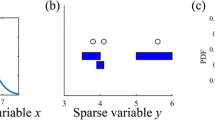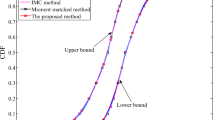Abstract
In this paper, a new method is put forward for simultaneous reliability and reliability-sensitivity analyses based on the information-reuse of sparse grid numerical integration (SGNI). First, the reliability analysis is conducted on the basis of fractional exponential moments-based maximum entropy method (FEM-MEM), where the SGNI is employed for FEM assessments. The reliability index can be evaluated by integrating over the distribution derived by FEM-MEM. Then, the reliability-sensitivity analysis is carried out by reusing the output samples in previous reliability analysis and updating the corresponding weights, where no additional model evaluations are required. Then, the FEM-MEM is applied again to derive the conditional distribution and reliability index. By comparing the conditional and original reliability indexes, one can define the reliability-sensitivity index to identify the importance of each random variable to reliability. Since only one-round of model evaluations are necessary in the proposed method, the computational efficiency is highly desirable. Four numerical examples are investigated to check the effectiveness of the proposed method, where pertinent results obtained from Monte Carlo simulations (MCS) and Sobol’s index are compared. The results demonstrate the proposed method is accurate and efficient for simultaneous reliability and reliability-sensitivity analyses.



















Similar content being viewed by others
References
Au S-K, Beck JL (2001) Estimation of small failure probabilities in high dimensions by subset simulation. Probab Eng Mech 16(4):263–277
Blatman G, Sudret B (2011) Adaptive sparse polynomial chaos expansion based on least angle regression. J Comput Phys 230(6):2345–2367
Borgonovo E, Plischke E (2016) Sensitivity analysis: a review of recent advances. Eur J Oper Res 248(3):869–887
Ditlevsen O, Madsen HO (1996) Structural reliability methods, vol 178. Wiley, New York
Dwight RP, Desmedt SG, Omrani PS (2016) Sobol indices for dimension adaptivity in sparse grids. In: Simulation-Driven Modeling and Optimization, Springer, pp 371–395
Echard B, Gayton N, Lemaire M (2011) Ak-mcs: an active learning reliability method combining kriging and monte carlo simulation. Struct Saf 33(2):145–154
Engelund S, Rackwitz R (1993) A benchmark study on importance sampling techniques in structural reliability. Struct Saf 12(4):255–276
Fallahi N (2021) Ga optimization of variable angle tow composites in buckling and free vibration analysis through layerwise theory. Aerospace 8(12):376
Forooghi A, Fallahi N, Alibeigloo A, Forooghi H, Rezaey S (2022) Static and thermal instability analysis of embedded functionally graded carbon nanotube-reinforced composite plates based on hsdt via gdqm and validated modeling by neural network, Mechanics Based Design of Structures and Machines pp 1–34
Gasanov M, Petrovskaia A, Nikitin A, Matveev S, Tregubova P, Pukalchik M, Oseledets I (2020) Sensitivity analysis of soil parameters in crop model supported with high-throughput computing. In: International Conference on Computational Science, Springer, pp 731–741
Giap GE, Kosuke N (2014) Sensitivity analysis using Sobol ‘variance-based method on the Haverkamp constitutive functions implemented in richards’ water flow equation, Malaysian. J Soil Sci 18:19–33
Gramacy RB, Taddy M (2009) Categorical inputs, sensitivity analysis, optimization and importance tempering with tgp version 2, an r package for treed gaussian process models, University of Cambridge Statistical Laboratory Tech. Rep
Haldar A, Mahadevan S (1995) First-order and second-order reliability methods. In: Probabilistic structural mechanics handbook, Springer, pp 27–52
Hastie T, Tibshirani R, Friedman JH, Friedman JH (2009) The elements of statistical learning: data mining, inference, and prediction, vol 2. Springer, New York
He J, Gao S, Gong J (2014) A sparse grid stochastic collocation method for structural reliability analysis. Struct Saf 51:29–34
He W, Zeng Y, Li G (2019) A novel structural reliability analysis method via improved maximum entropy method based on nonlinear mapping and sparse grid numerical integration. Mech Syst Signal Process 133:106247
He S, Xu J, Zhang Y (2022) Reliability computation via a transformed mixed-degree cubature rule and maximum entropy. Appl Math Modell 104:122–139
Heiss F, Winschel V (2008) Likelihood approximation by numerical integration on sparse grids. J Econom 144(1):62–80
Helton JC, Johnson JD, Sallaberry CJ, Storlie CB (2006) Survey of sampling-based methods for uncertainty and sensitivity analysis. Reliab Eng Syst Saf 91(10–11):1175–1209
Heo Y, Choudhary R, Augenbroe G (2012) Calibration of building energy models for retrofit analysis under uncertainty. Energy Build 47:550–560
Hygh JS, DeCarolis JF, Hill DB, Ranjithan SR (2012) Multivariate regression as an energy assessment tool in early building design. Build Environ 57:165–175
Iooss B, Lemaître P (2015) A review on global sensitivity analysis methods, In: Uncertainty management in simulation-optimization of complex systems, Springer, pp 101–122
Li L, Lu Z (2017) Variance-based sensitivity analysis for models with correlated inputs and its state dependent parameter solution. Struct Multidisc Optim 56(4):919–937
Li H, Lü Z, Yuan X (2008) Nataf transformation based point estimate method. Chin Sci Bull 53(17):2586–2592
Li G, He W, Zeng Y (2019) An improved maximum entropy method via fractional moments with laplace transform for reliability analysis. Struct Multidisc Optim 59(4):1301–1320
Mooney CZ (1997) Monte carlo simulation, no. 116, Sage
Oakley JE, O’Hagan A (2004) Probabilistic sensitivity analysis of complex models: a Bayesian approach. J R Stat Soc Ser B 66(3):751–769
Petras K (2001) Fast calculation of coefficients in the Smolyak algorithm. Numer Algorithms 26(2):93–109
Rakovec O, Hill MC, Clark M, Weerts A, Teuling A, Uijlenhoet R (2014) Distributed evaluation of local sensitivity analysis (delsa), with application to hydrologic models. Water Resour Res 50(1):409–426
Saltelli A, Tarantola S, Campolongo F, Ratto M (2004) Sensitivity analysis in practice: a guide to assessing scientific models, vol 1. Wiley, New York
Saltelli A, Ratto M, Tarantola S, Campolongo F (2005) Sensitivity analysis for chemical models. Chem Rev 105(7):2811–2828
Tian W (2013) A review of sensitivity analysis methods in building energy analysis. Renew Sustain Energy Rev 20:411–419
Wang L, Li G, Lu Z, Feng K (2021) Local sensitivity analysis of failure possibility and its universal solution by fuzzy simulation. Struct Multidisc Optim 64(1):219–238
Wei P, Lu Z, Song J (2015) Variable importance analysis: a comprehensive review. Reliab Eng Syst Saf 142:399–432
Xiao N-C, Huang H-Z, Wang Z, Pang Y, He L (2011) Reliability sensitivity analysis for structural systems in interval probability form. Struct Multidisc Optim 44(5):691–705
Xiong F, Xiong Y, Greene S, Chen W, Yang S (2009) A new sparse grid based method for uncertainty propagation. In: International Design Engineering Technical Conferences and Computers and Information in Engineering Conference, vol 49026, pp 1205–1215
Xu J (2016) A new method for reliability assessment of structural dynamic systems with random parameters. Struct Saf 60:130–143
Xu J, Dang C (2019) A novel fractional moments-based maximum entropy method for high-dimensional reliability analysis. Appl Math Modell 75:749–768
Xu J, Dang C (2019) A new bivariate dimension reduction method for efficient structural reliability analysis. Mech Syst Signal Process 115:281–300
Xu J, Kong F (2019) Adaptive scaled unscented transformation for highly efficient structural reliability analysis by maximum entropy method. Struct Saf 76:123–134
Xu J, Dang C, Kong F (2017) Efficient reliability analysis of structures with the rotational quasi-symmetric point-and the maximum entropy methods. Mech Syst Signal Process 95:58–76
Xu J, Du Y, Zhou L (2021) A multi-fidelity integration rule for statistical moments and failure probability evaluations. Struct Multidisc Optim 64(3):1305–1326
Yang H, Hong SH, Wang Y (2022) A sequential multi-fidelity surrogate-based optimization methodology based on expected improvement reduction. Struct Multidisc Optim 65(5):1–17
Zhan Y, Zhang M (2013) Application of a combined sensitivity analysis approach on a pesticide environmental risk indicator. Environ Modell Softw 49:129–140
Zhang Y, Xu J (2021) Efficient reliability analysis with a cda-based dimension-reduction model and polynomial chaos expansion. Comput Methods Appl Mech Eng 373:113467
Zhao Y-G, Ono T (2001) Moment methods for structural reliability. Struct saf 23(1):47–75
Acknowledgements
The National Natural Science Foundation of China (Nos. 51978253, 52278178, 52078485), Natural Science Foundation of Hunan Province (No. 2022JJ20012), and the Science and Technology Research and Development Program Project of China railway group limited (Project Nos. 2020-Special-02, 2021-Special-08 and 2021-Major-16) are gratefully appreciated for the financial support of this research.
Author information
Authors and Affiliations
Contributions
Jun Xu (xujun86@hnu.edu.cn): Conceptualization, Methodology, Investigation, Writing-original draft, Writing-review & editing, Supervision, Funding acquisition. Limin Hao: Data curation, Methodology, Investigation, Validation, Visualization, Writing-original draft, Writing-review & editing. Jian-feng Mao: Funding acquisition, Conceptualization, Methodology, Investigation, Writing-review & editing. Zhi-wu Yu: Writing-review & editing.
Corresponding author
Ethics declarations
Conflict of interest
The authors declare there are no conflicts of interest regarding the publication of this paper.
Replication of results
Some or all data, models, or code generated or used during the study are available from the corresponding author by request.
Additional information
Responsible Editor: Pingfeng Wang
Publisher's Note
Springer Nature remains neutral with regard to jurisdictional claims in published maps and institutional affiliations.
Appendix A: Sobol’s sensitivity index
Appendix A: Sobol’s sensitivity index
Sensitivity analysis is used to analyze the contribution of parameters to the output value, which can be used to obtain the importance of the influence of parameters on the model. Sobol’s sensitivity analysis (Giap and Kosuke 2014) is a method based on variance to obtain various sensitivity indexes whose values vary from 0 to 1. The closer the index value is to 1, the greater the influence of this variable on the results. On the contrary, the closer the index value is to 0, the less the influence of this variable on the results. In this paper, we mainly consider the first-order Sobol’s index and the total Sobol’s index (Zhan and Zhang 2013; Gasanov et al. 2020; Dwight et al. 2016), which are widely applied in sensitivity analysis.
Consider a function as
where Y is the model output and \({\mathbf{{X}} = (X_1, X_2, X_3,\ldots,X_D)^{T}}\) is an D-dimensional random vector of input parameters. In the Sobol’s method, the total unconditional variance V(Y) can be broken down into the following parts
where
Therefore, the first-order sensitivity index \({S_i}\) which represents the influence of input variable \({X_i}\) alone can be expressed as
Similarly, the second-order sensitivity index \({S_{ij}}\) representing the interaction between \({X_i}\) and \({X_j}\) can also be calculated such that
The other high-order sensitivity indexes can be represented as
The total sensitivity index \({S_{T_{i}}}\) is the sum of the effects of input variable \({X_i}\) and its interactions, which can be formulated as follows
For example, when \(D=4\),
Rights and permissions
Springer Nature or its licensor (e.g. a society or other partner) holds exclusive rights to this article under a publishing agreement with the author(s) or other rightsholder(s); author self-archiving of the accepted manuscript version of this article is solely governed by the terms of such publishing agreement and applicable law.
About this article
Cite this article
Xu, J., Hao, L., Mao, Jf. et al. Simultaneous reliability and reliability-sensitivity analyses based on the information-reuse of sparse grid numerical integration. Struct Multidisc Optim 66, 7 (2023). https://doi.org/10.1007/s00158-022-03444-1
Received:
Revised:
Accepted:
Published:
DOI: https://doi.org/10.1007/s00158-022-03444-1




